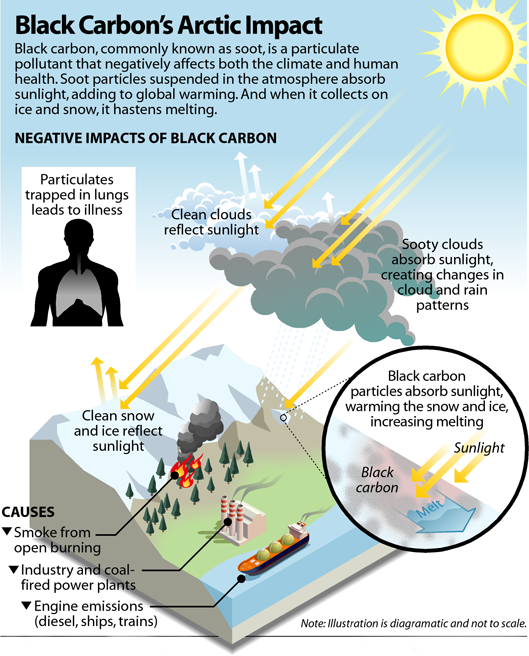Biodiversity & Environment
Black Carbon
- 20 Dec 2022
- 6 min read
For Prelims: Black Carbon, ISRO, carbon dioxide, greenhouse gas emissions, climate change.
For Mains: Environmental Pollution & Degradation, Conservation
Why in News?
In Lok Sabha, the Minister of State for Environment, Forest and Climate Change outlined the various measures taken to counter black carbon.
- Under the Indian Space Research Organization (ISRO) Geosphere Biosphere Programme, the ISRO operates a network of aerosol observatories and black carbon mass concentration is one of the parameters being measured.
What is Black Carbon?
- About: Black Carbon (BC) is a short-lived pollutant that is the second-largest contributor to warming the planet behind carbon dioxide (CO2).
- Unlike other greenhouse gas emissions, BC is quickly washed out and can be eliminated from the atmosphere if emissions stop.
- Unlike historical carbon emissions it is also a localised source with greater local impact.
- Black carbon is a kind of an aerosol.
- General Impacts: Among aerosols (such as brown carbon, sulphates), Black Carbon has been recognized as the second most important anthropogenic agent for climate change and the primary marker to understand the adverse effects caused by air pollution.
- Black carbon absorbs solar energy, it warms the atmosphere. When it falls to earth with precipitation, it darkens the surface of snow and ice, reducing their albedo (the reflecting power of a surface), warming the snow, and hastening melting.
- Emission: It gets emitted from gas and diesel engines, coal-fired power plants, and other sources that burn fossil fuel. It comprises a significant portion of particulate matter or PM, which is an air pollutant.
What are the Various Measures taken?
- Pradhan Mantri Ujjwala Yojana:
- Under this initiative, the government is promoting use of cleaner household cooking fuels.
- BS VI Emission Norms:
- Leapfrogging from BS-IV to BS-VI norms for fuel and vehicles from 1st April, 2020.
- Introducing Cleaner Fuels:
- Introduction of cleaner / alternate fuels like gaseous fuel (CNG, LPG etc.), ethanol blending.
- SATAT Scheme:
- A new initiative, “Sustainable Alternative Towards Affordable Transportation (SATAT), has been launched to set up 5000 Compressed Bio-Gas (CBG) production plants and make CBG available in the market for use.
- Managing Crop Residue:
- Agricultural machines and equipment for in-situ crop residue management in Punjab, Haryana, Uttar Pradesh and NCT of Delhi are promoted under the Central Sector Scheme on Promoting Agricultural Mechanization for in-situ Crop Residue Management with 50% subsidy to individual farmers and 80% subsidy to the establishment of Custom Hiring Centres.
- National Clean Air Programme:
- The Central Government is implementing the National Clean Air Programme as a long-term, time-bound, national-level strategy to tackle the air pollution problem across the country in a comprehensive manner.
- The Centre has set a new target of a 40% reduction in particulate matter concentration in cities covered under the scheme by 2026, updating the earlier goal of 20 to 30% reduction by 2024.
- City specific Clean Air Action Plans:
- The Central Pollution Control Board (CPCB) has identified 131 cities based on ambient air quality levels exceeding national ambient air quality standards, and cities with a million plus population.
- City specific Clean Air Action Plans have been prepared and rolled out for implementation in these cities.
- These plans define time bound targets to control city specific air polluting sources (soil & road dust, vehicles, domestic fuel, municipal solid waste burning, construction material and industries, etc.).
- FAME Scheme:
- Faster Adoption and Manufacturing of Electric Vehicles (FAME) phase-2 scheme has been rolled out.
UPSC Civil Services Examination, Previous Year Questions (PYQs)
Prelims
Q. Consider the following which can be found in the ambient atmosphere: (2010)
- Soot
- Sulphur hexafluoride
- Water vapour
Which of the above contribute to the warming up of the atmosphere?
(a) 1 and 2 only
(b) 3 only
(c) 2 and 3 only
(d) 1, 2 and 3
Ans: (d)
Exp:
- Soot, also known as black Carbon, is a black, carbonaceous substance produced during incomplete combustion of coal, wood, etc. Black Carbon contributes to climate warming in two ways.
- First, black soot particles in the air absorb sunlight and directly heat the surrounding air
- Second, soot falling on snow changes the reflecting surfaces into absorbing ones, i.e., soot decreases the albedo and therefore, increases the melting rate of snow and ice. Hence, 1 is correct.
- As per IPCC, Sulphur Hexafluoride (SF6 ) is the most potent greenhouse gas, with a global warming potential of 23,900 times that of CO2 over a 100 year of time period. Hence, 2 is correct.
- Water vapor is known to be Earth’s most abundant greenhouse gas, which results in heating of the atmosphere. Hence, 3 is correct. Therefore, option (d) is the correct answer.
Mains
Q. Mumbai, Delhi and Kolkata are the three mega cities of the country but the air pollution is much more serious problem in Delhi as compared to the other two. Why is this so? (2015)





